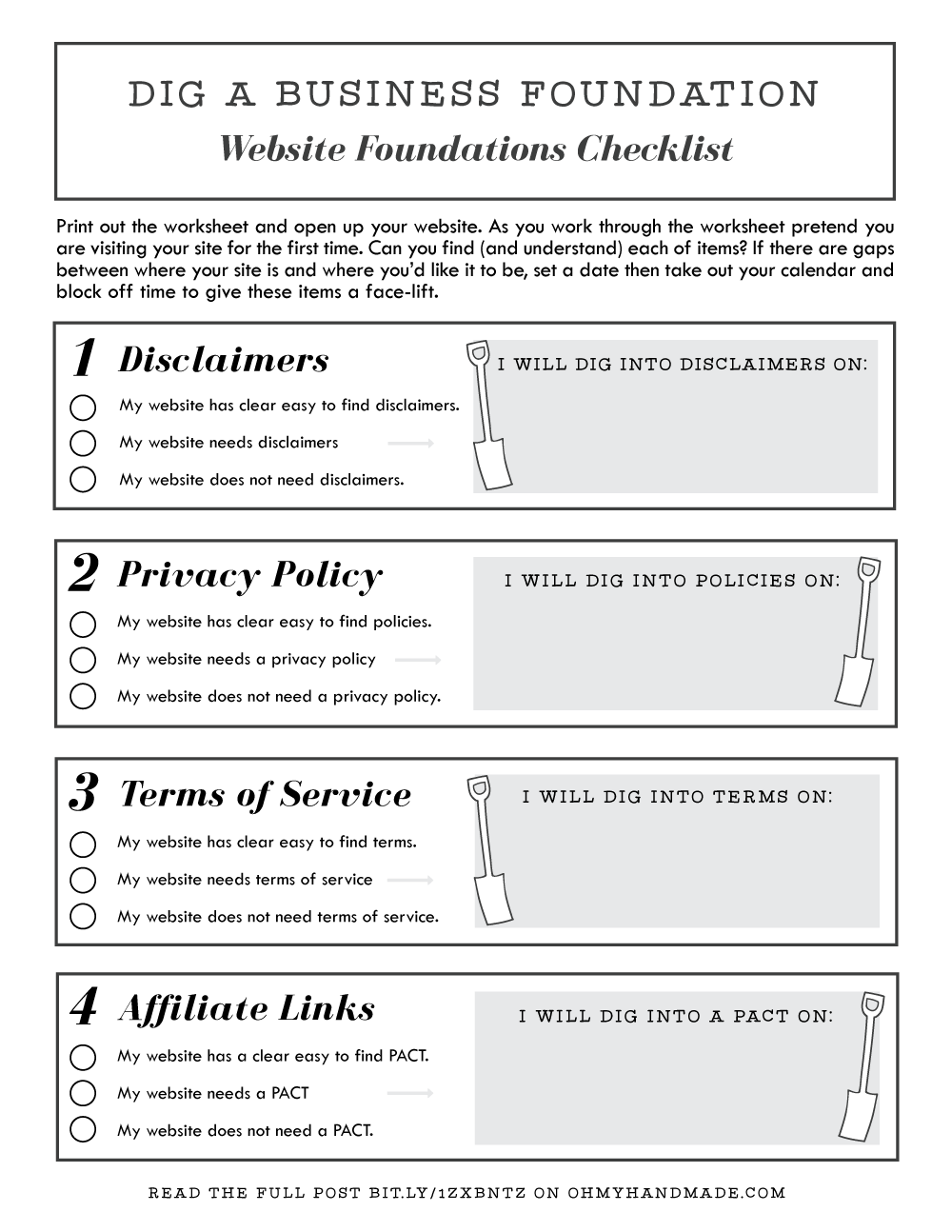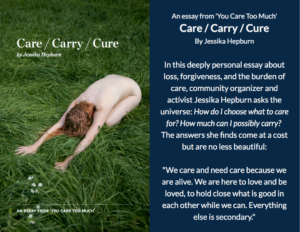

Also in this series: {Part 2: Contracts} | {Part 3: Structure | {Part 4:} Intellectual Property
I bet you, like me, start off the New Year with huge dreams for what the year will hold. I like to pick a theme for the year. In 2015 I’m working on cultivating a strong community, both online and offline. So when I sat down and created my 2015 business plan, I made sure that the goals and activities I selected reinforced this theme. While our 2015 goals are likely different, to accomplish these goals we both must have a solid business foundation in place.
Digging in and working on your business’ foundation, I’ll admit, isn’t very fun. I know that when I wear this hat I often have to give myself a little tough love and a kick in the pants. This is because working on the foundation of our businesses doesn’t fit in a 140-character tweet or a pretty Instagram picture. It requires us to admit to ourselves what our vision is, create a plan, and then execute it. And often this plan requires lots of not-so-fun, not-so-creative tasks.
Because of this, the foundations of our business often get ignored. We focus on attracting social media followers, getting our products in publications, and guest posting – the shiny things that are fun to share with friends and that give us an upswing on the roller coaster of running a creative business. And things like drafting terms of service, having a solid client contract, or registering our copyrights fall to the bottom of the to-do list and off the radar.
But what happens when you get your big break? If the foundation of your business isn’t set up to support it, then you’ll have to scramble to get things in place.
If you are anything like me, you don’t make your best decisions when you are reacting. I am definitely on the side of the fence that thinks best when I have time to thoughtfully work through and weigh all my options. I do my best work when I’m being proactive and setting up solutions for possibilities, hoping that some of these possibilities never come to pass. There’s been more than one instance where I’ve created a solution on the fly that wasn’t right for my business and so I’ve had to go back and totally repeat a project, costing me not only time, but money.
I also know that selecting and prioritizing which aspects of your business foundation to work on can be overwhelming. To help you out, this month we are going to work on shoring up four areas of your business foundation: website, contracts, business structure, and intellectual property. As we move through each area, we’ll discover what gaps exist between where your foundation currently is and where you’d like it to be. Each area will have a short exercise to help you identify and prioritize the most important tasks you can take this year to reinforce the foundation of your business.
So take out your calendar right now and block off four 20-minute blocks this month to work through each of the exercises. Because when Martha Stewart, Oprah, or Ellen calls and your big break is on the horizon I want you to be thanking your lucky stars, not scrambling to get things in place to support the influx of new fans to you and your work. Let’s dive right into looking at the foundations of your website.
Your Website
Our websites are often the first interaction clients and customers have with our brand. I know only too well how easy it is to get caught up in selecting the right template, font, and color palette for your website. Don’t get me wrong, these shiny parts of our website do matter and will impact if your ideal clients and customers stick around. But your website’s foundation is built on some not-so-fun, not-so-creative parts: disclaimers, privacy policies, terms of service, and affiliate links.
These foundational aspects of your website will help protect your butt if, or when, one of your clients/customers goes crazy on you. Not to mention that some of these are legal requirements and not having them can land you in hot water. Click here or the graphic below to download your website foundations checklist.
Disclaimers
We encounter disclaimers on a daily basis. Disclaimers are created when there is a risk of something bad happening, but we can’t be sure if that outcome will happen this time.
For example, you enter a parking lot and there’s a disclaimer when you enter (or on your ticket) that says the garage is not responsible if your car gets stolen or broken into when it’s parked in their garage. The garage knows that occasionally this will happen, even though they have cameras and staff on site, but they don’t know exactly when it will happen. So they tell you that you have to park at your own risk.
Do you do any of the following on your website?
- Give advice
- Make promises or guarantees
- Sell products that could cause an allergic reaction
- Sell products that vary piece to piece
- Allow users to generate content
Then you can (and should) have a disclaimer. For example on my site, I tell visitors that my site is an educational resource; not a replacement for working one-on-one with a lawyer. If you include health and nutrition tips on your website, you might want to disclaim that you aren’t a licensed medical professional. If you provide small business or social media advice you might want to tell them that you can’t guarantee that they will get the same results.
Privacy Policy
As was pointed out in an earlier OMHG post if your website attracts visitors from California, it’s a legal requirement to have a privacy policy. The goal of a privacy policy is to make it transparent to visitors what information you are gathering on them and what you do with it. While these rules can seem complicated, if you keep in mind that they are all about making it clear to me, a visitor to your website, what you know about me and my Internet surfing habits, then the rules start to make a little more sense.
When you are developing your privacy policy tell visitors the answers to the following questions:
- What kind of information are you collecting on them and how?
- Who is collecting this information?
- How are you using this information?
- How do you protect sensitive identifiable information?
- Do you share this information with others? If so, who, what, and how?
- How can a visitor find out what information you have on her? Who does she contact? How long will it take you to provide it to her? Does she have to pay a research fee?
- When was this privacy policy last updated?
- What is the process for updating the privacy policy?
When answering these questions you should not only consider user-generated information (e.g. sales pages, contact forms, or comments) but information that is automatically collected (e.g. Google Analytics, MailChimp, or Shopify). Also don’t forget to keep in mind third parties you share this information with (e.g. do you give it in the aggregate to sponsors, affiliates, or partners).
Terms of Service
I like to think of contracts as outlining the boundaries of your relationship. And terms of service is just a fancy word for the contract between you and your website visitors.
When developing your terms of service tell visitors the rules around each of these topics:
- E-commerce rules: Explain to visitors your policies around: payment, shipping, refunds, and exchanges.
- Comment rules: Explain to visitors your policies surrounding comments. Are promotional comments allowed? Are comments moderated? What happens if I break the rules?
- Intellectual property rules: Explain to visitors how they can use the content on your site (this is extra important for those of you that do DIYs and tutorials on your site) and the process to contact you if they think your site infringes on their content.
- Rules about change: Explain to visitors the process for changing the terms of service.
Affiliate Links
If part of your business model is creating content based on sponsors or if you are part of an affiliate program, then you need to make it clear to visitors that you are getting a kickback in exchange for your review, comments, or link.
Again, the rules around this are pretty common sense when you think about them from the consumer’s standpoint. I should know if you are writing about this awesome blender because you got it for free or if you use it everyday in your own kitchen.
There are four elements to properly disclosing your affiliate/sponsor relationships:
- Placement: You can’t hide the disclosure in the footer. It must be conspicuous and obvious to website visitors.
- Action: Visitors can’t be required to take extra steps to read the disclosure (e.g. no click-through links).
- Clear: Visitors must be able to easily understand that you are getting compensation in exchange for placement on your website.
- Timing: You can’t just tell visitors once; the disclosure must be tied to every post, social media interaction, link, or comment related to that product or service you are pimping.
(I like to remember these as the PACT I’m making with my visitors.)
Print out the worksheet and open up your website. As you work through the worksheet pretend you are visiting your site for the first time. Can you find (and understand) each of items? If there are gaps between where your site is and where you’d like it to be, take out your calendar and block off time to give these items a face-lift.
Congrats! You’ve now reinforced the foundation of your business by getting your website legit.
I’d love to know in the comments below the area of your site that you are going to tackle next. Or if you are all squared away, let us know so we can give you a high five.
Kiffanie Stahle | The artist’s JD
 Kiffanie Stahle is a lawyer, photographer, and small business owner. In April 2014, she created the artist’s JD, a place where creative business owners can get the tools and resources they need to tackle the legal aspects of their businesses. Kiffanie believes that the law doesn’t have to be scary or hard to understand. And she knows this to be true because she’s been practicing law since 2011. When Kiffanie is not creating art or running her business, you might find her concocting something in the kitchen, soaking up the sun, or plotting her next adventure.
Kiffanie Stahle is a lawyer, photographer, and small business owner. In April 2014, she created the artist’s JD, a place where creative business owners can get the tools and resources they need to tackle the legal aspects of their businesses. Kiffanie believes that the law doesn’t have to be scary or hard to understand. And she knows this to be true because she’s been practicing law since 2011. When Kiffanie is not creating art or running her business, you might find her concocting something in the kitchen, soaking up the sun, or plotting her next adventure.
WEBSITE | FACEBOOK | TWITTER | INSTAGRAM
This is part 1 of a 4 part series publishing every Thursday in January to help you dig a solid foundation for your business in 2015! Mark your calendars for a special Q & A #OMHG chat with Kiffanie on Twitter, January 29th from 1-2pm EST.
Also in this series: {Part 2: Contracts} | {Part 3: Structure | {Part 4:} Intellectual Property



[…] http://ohmyhandmade.com/2015/head/entrepreneurship/foundation-part1/ […]